Indulge in the Earthy Delights: Hen of the Woods Pasta with Creamy Tarragon Sauce
There are few culinary delights that truly capture the essence of the forest quite like Hen of the Woods mushrooms. Also known as Maitake, this prized fungus holds a special place in the hearts of gourmets and home cooks alike, and for good reason! Its rich, savory flavor and unique texture transform any dish, taking it from ordinary to extraordinary. Our Hen of the Woods Pasta with Creamy Tarragon Sauce is a testament to this mushroom’s incredible versatility, offering a truly mouthwatering experience that will have you craving more with every single forkful. This recipe isn’t just a meal; it’s an exploration of deep, earthy flavors perfectly balanced with a luxurious, aromatic cream sauce.
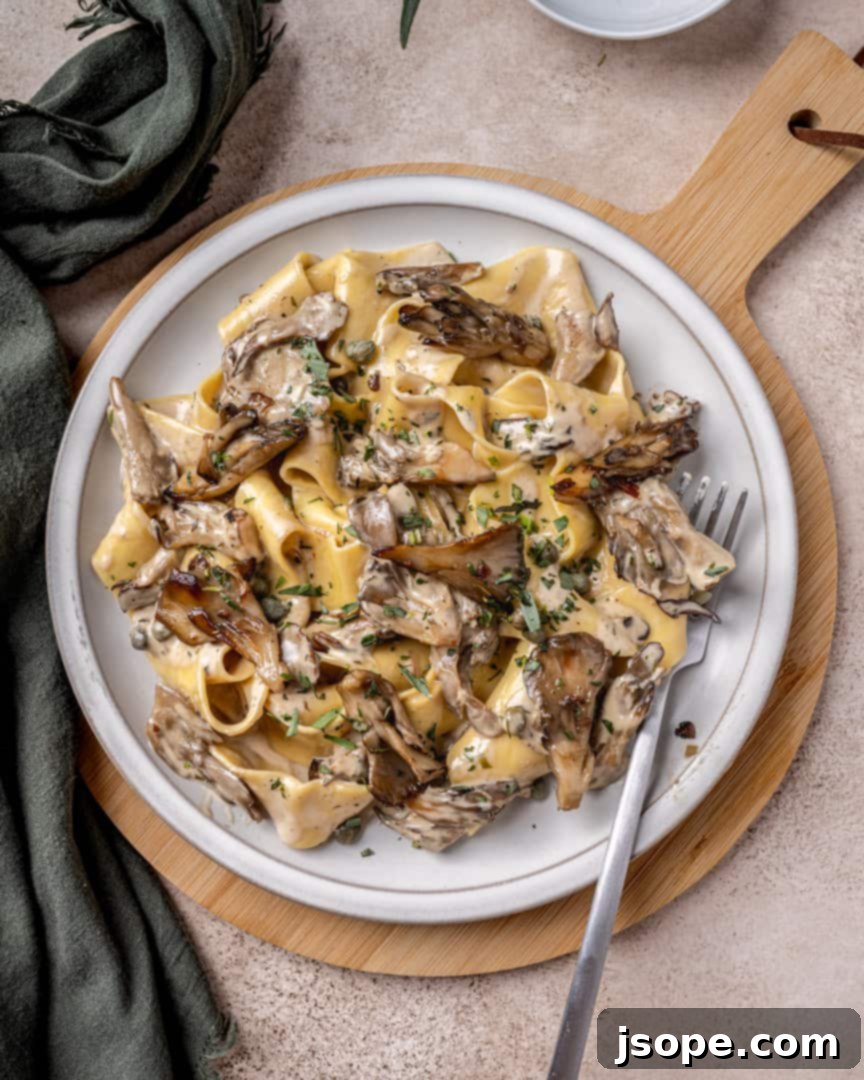
What are Hen of the Woods Mushrooms (Maitake)?
Hen of the Woods mushrooms, scientifically known as Grifola frondosa, are a fascinating variety that can be either artfully foraged from the wild or skillfully cultivated. They are celebrated for their distinctive bold, earthy flavor profile and a satisfyingly meaty texture that sets them apart from many other mushroom varieties. Often described as savory with subtle sweet and nutty undertones, their complex taste makes them an exceptional choice for this creamy pasta recipe.
This remarkable mushroom boasts several intriguing names across cultures. Most famously, it’s known as Maitake, a Japanese term meaning “dancing mushroom.” Legend has it that people would dance with joy upon finding these valuable clusters in the wild due to their incredible taste and perceived health benefits. Other names include Kumotake in some parts of Japan and “Signorina” in Italy, adding to its mystique. Visually, Hen of the Woods mushrooms are easily recognizable by their fan-shaped caps that form large, overlapping clusters, typically displaying shades of brown and gray. It’s crucial not to confuse them with “Chicken of the Woods” mushrooms, despite the similar name. Chicken of the Woods (Laetiporus sulphureus) is strikingly different in color (bright orange/yellow), shape, and flavor, and should not be used as a substitute for Maitake.
In their natural habitat, these impressive fungi can grow to astonishing sizes, with clusters weighing over 10 pounds being a common find. Beyond their culinary appeal, Maitake mushrooms are also highly regarded for their potential health benefits. They are rich in antioxidants, B vitamins, and minerals, and have been studied for their immune-boosting properties. Their robust structure also makes them quite forgiving to cook, making them suitable for a wide array of culinary applications, from sautéing and roasting to simmering in sauces, just like in this delicious pasta dish.
For another delightful way to enjoy Maitake, explore this Maitake Mushroom Toast recipe from our friend Kirby’s blog, Leisure Fan Club!
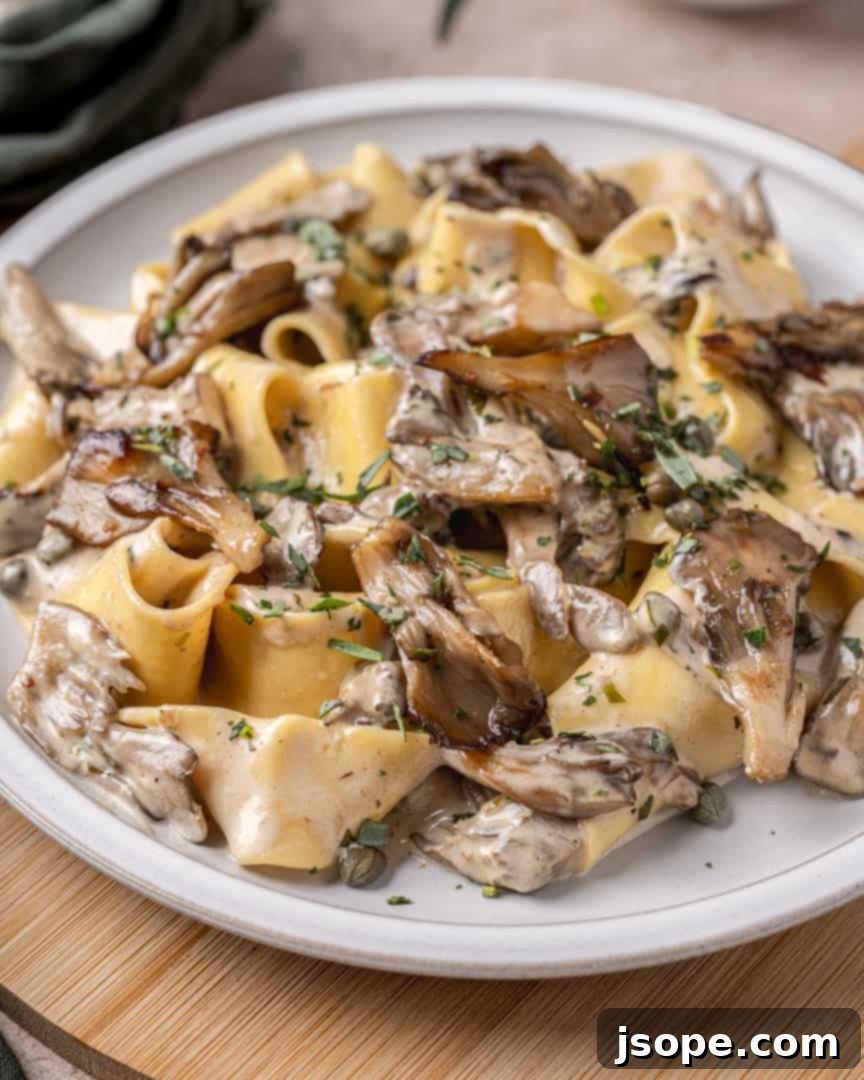
Sourcing Your Maitake: Foraging vs. Finding in Stores
The allure of Hen of the Woods mushrooms often begins with their natural habitat. If you possess a keen eye for foraging and a deep understanding of local flora, you might find these treasures growing at the base of oak trees in wooded areas during the autumn months. They are prevalent in the northern regions of North America, Japan, China, and various parts of Europe. However, foraging should always be approached with extreme caution and expert knowledge, as misidentification can lead to serious health risks. Always consult an experienced forager or field guide before consuming any wild mushrooms.
For those of us less adventurous or without foraging expertise, cultivated Hen of the Woods mushrooms offer a safe and reliable option. While they can be cultivated year-round with specialized equipment, their cultivation is known to be more challenging than some other mushroom varieties, which can result in a higher price point. This premium reflects their unique flavor and the effort involved in bringing them to market.
We typically source our Maitake from specialty grocery stores and local farmer’s markets, where quality and freshness are often prioritized. These outlets frequently carry a wider selection of gourmet ingredients, including seasonal wild mushrooms. For instance, in Texas, Central Market is a reliable source for these mushrooms throughout the year. Additionally, some well-stocked Asian grocery stores, such as Super H Mart, occasionally feature them, especially during peak season. When purchasing, look for firm, fresh-looking clusters without any signs of sliminess or decay.
Crafting the Perfect Creamy Tarragon Pasta Sauce: Ingredients and Substitutions
This vegetarian pasta dish relies on a harmonious blend of flavors to create its signature creamy tarragon sauce. Each ingredient plays a vital role in building depth and complexity, ensuring a truly unforgettable culinary experience. Here’s a closer look at the components that make this sauce so special:
Key Ingredients:
- Hen of the Woods Mushrooms (Maitake mushrooms)
- Unsalted Butter
- Olive Oil (Extra Virgin)
- Shallot and Garlic
- Dry White Wine (Pinot Grigio or Sauvignon Blanc recommended)
- Capers
- Heavy Cream
- Fresh Tarragon
- Kosher Salt and Black Pepper
- Balsamic Vinegar (a few drops)
The Star Ingredient: Hen of the Woods Mushrooms
As the namesake and heart of this recipe, Hen of the Woods mushrooms provide a robust, earthy, and slightly peppery flavor with a wonderfully resilient, meaty texture. They hold up beautifully in the rich cream sauce, absorbing its flavors while maintaining their distinct character. If fresh Maitake are unavailable, oyster mushrooms make an excellent wild mushroom substitute, offering a delicate texture and earthy flavor. For more readily available options, cremini mushrooms (baby bellas) or shiitake mushrooms can also be used, though they will impart a slightly different flavor profile. The goal is a mushroom that provides a good bite and can stand up to the creamy sauce.
Aromatic Foundation: Shallot and Garlic
Shallots and garlic are the quintessential aromatics for any savory cream sauce, and they shine particularly brightly when paired with mushrooms. Their subtle, sweet, and pungent notes create a foundational layer of flavor, adding depth and warmth without overpowering the delicate nuances of the mushrooms and tarragon. Finely chopping them allows their essences to meld seamlessly into the sauce, contributing to a harmonious overall taste.
The Brightness of Dry White Wine
A splash of dry white wine, such as Pinot Grigio or Sauvignon Blanc, is crucial for deglazing the pan and adding a layer of sophisticated acidity to the sauce. The wine helps to lift all the flavorful browned bits from the pan, known as “fond,” infusing the sauce with complex undertones. It also provides a welcome counterpoint to the richness of the cream, ensuring the sauce remains balanced and vibrant rather than heavy.
Briny Burst: Capers
These tiny, briny flower buds are a small but mighty addition to the dish. Capers deliver a bright, tangy, and slightly salty punch that cuts through the richness of the cream sauce. They add an unexpected burst of flavor that elevates the entire dish, providing a delightful contrast and an intriguing complexity that we find absolutely irresistible.
The Unique Essence of Tarragon
Tarragon is arguably one of the best herbs to pair with mushrooms, especially in a cream-based sauce. Its distinctive flavor is often described as subtly reminiscent of fennel or anise, with sweet, mildly licorice-like notes. While the mention of licorice might deter some, please don’t let it! In this recipe, surrounded by the earthy mushrooms, savory aromatics, and rich cream, the tarragon performs a magical balancing act. It adds a delicate sweetness and a sophisticated herbal freshness that perfectly rounds out the dish, creating an exquisite flavor combination that truly highlights the mushrooms. Fresh tarragon is key here; dried tarragon, while usable, won’t offer the same vibrant aromatic quality.
If you discover a love for tarragon, you might also enjoy our recipe for Poached Halibut with Tarragon Cream Sauce!
The Secret Weapon: Balsamic Vinegar
A few drops of good quality balsamic vinegar are the secret ingredient that pulls all the flavors together in this dish. It’s not meant to make the sauce taste like vinegar, but rather to add a final layer of acidity and sweetness that brightens and deepens the overall profile. The difference before and after adding this ingredient is truly remarkable—it’s the magic touch that transforms a good sauce into a truly great one, adding an unexpected richness and complexity.
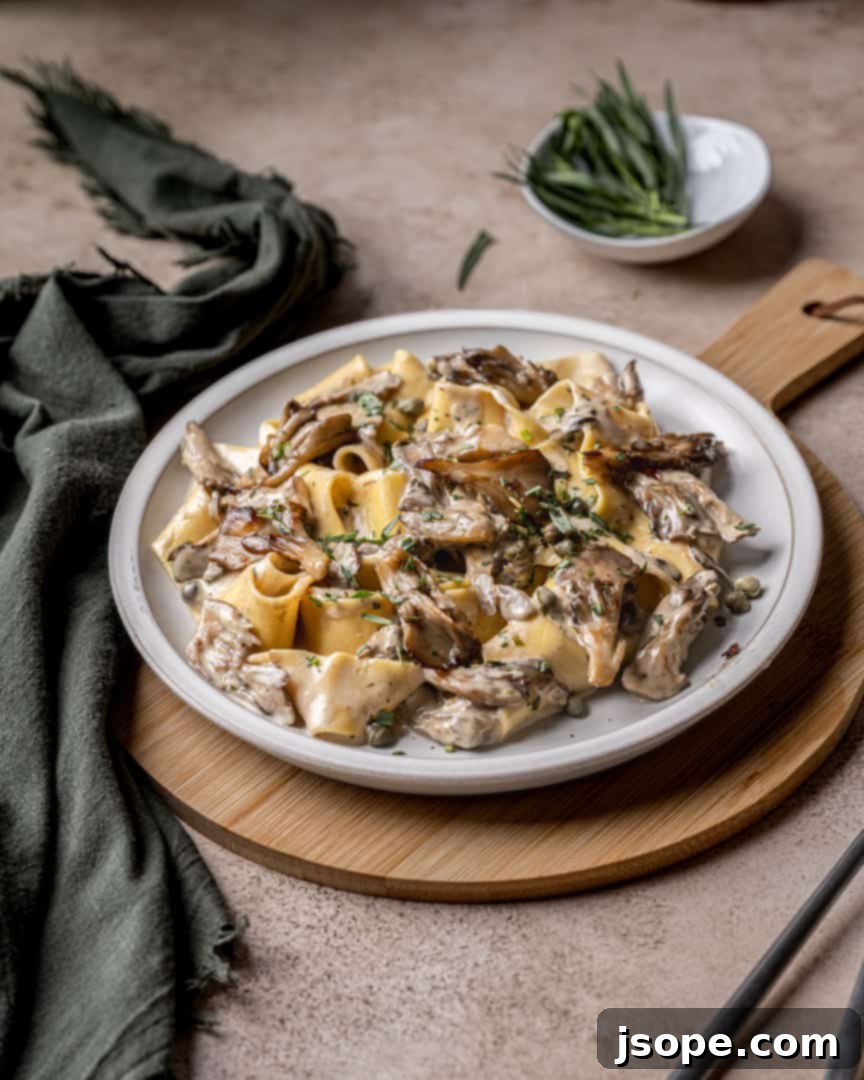
The Ideal Noodle: Homemade Pappardelle Pasta
Pappardelle, a renowned pasta shape originating from Tuscany, Italy, is characterized by its long, flat, and wide ribbon-like structure. Typically, these noodles range from ⅝” to ¾” (16-19mm) in width, with regional variations found throughout Italy. Its substantial size makes it an ideal companion for robust, hearty sauces, allowing it to elegantly scoop up generous amounts of flavor with each bite.
Traditionally, homemade pappardelle is crafted with a rich egg and wheat flour dough, which contributes to its distinct silky texture and satisfying bite. While it’s most famously served with slow-cooked meat or game ragùs, its versatility means it pairs beautifully with a myriad of sauces, including our rich mushroom cream sauce. In this recipe, the substantial nature of pappardelle perfectly complements the luscious, earthy flavors of the Hen of the Woods mushroom cream sauce. The inclusion of eggs in the pasta dough significantly enhances its texture, imparting a tender yet chewy quality that is simply divine. While egg pasta is often preferred for its luxurious feel, pasta made without eggs is equally cherished and will perform wonderfully in this dish, offering a slightly firmer bite. The silky texture of homemade egg pappardelle, however, creates an outstanding textural contrast and carries the rich sauce loaded with Hen of the Woods mushrooms with unparalleled grace.
Ready to embark on the rewarding journey of making your own pasta? Discover our comprehensive guide for Homemade Pasta! It’s a game-changer that will undoubtedly elevate your culinary skills!
Freezing Homemade Egg Pasta for Future Feasts
Yes, absolutely! Freezing homemade pasta is a fantastic way to enjoy the convenience of freshly made noodles without the immediate effort. You can freeze raw homemade egg pasta and store it for up to three months without compromising quality. To do this, ensure the pasta is lightly floured and dried just enough so it doesn’t stick together. You can either coil individual portions into “nests” or lay them flat on a baking sheet to flash freeze before transferring them to an airtight container or freezer bag. When you’re ready to cook, simply drop the frozen noodles directly into boiling water. It is crucial NOT to let them thaw beforehand, as this will cause them to clump together and become a mushy mess. Frozen pasta typically requires an additional 1-2 minutes of cooking time compared to fresh, unfrozen pasta, so adjust accordingly until it reaches your desired al dente tenderness.
Store-Bought Convenience: Opting for Quality Pasta
While homemade pappardelle offers an unparalleled experience, using good quality store-bought pasta is an absolutely viable and convenient alternative. Modern pasta producers offer excellent options that can still result in a fantastic dish. When selecting store-bought pappardelle, look for brands that use high-quality durum wheat semolina and ideally, those that are bronze-cut, as this creates a rougher texture that helps the sauce cling better to the noodles. Often, commercially produced pappardelle does not contain eggs, resulting in a firmer, chewier texture, which can be equally delightful with this rich sauce. Simply follow the package instructions precisely for cooking to an al dente finish. The key is to avoid overcooking, ensuring your pasta retains a pleasant bite that complements the creamy sauce.
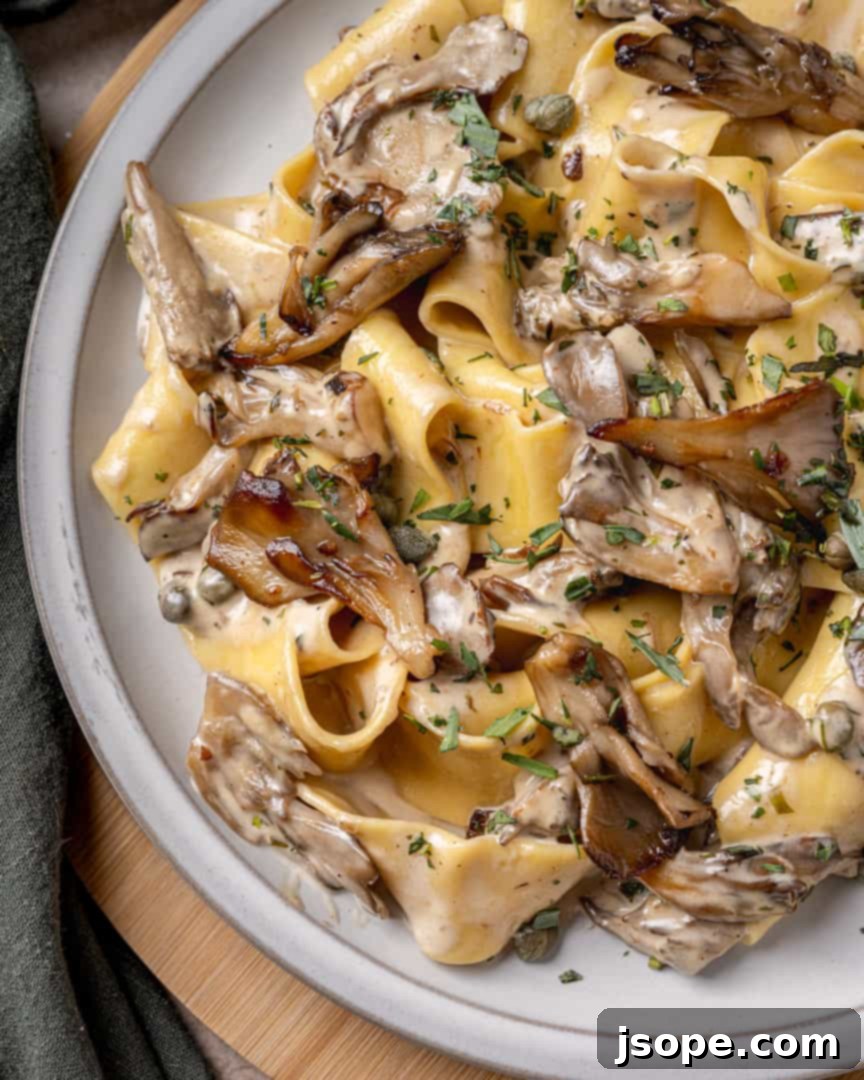
Mastering the Art of Cream Sauce: Pro Tips for Perfection
Creating a truly exceptional cream sauce might seem intimidating, but in reality, it’s quite straightforward. Cream sauces are forgiving, and with a few key techniques, you can easily elevate a good sauce to a truly magnificent one. There’s no need to be timid; confidence in the kitchen often yields the best results!
- Stir Regularly for Even Cooking: While it’s difficult to burn heavy cream, stirring the sauce semi-often during cooking is a good practice. This ensures even heat distribution, prevents any sticking, and helps the sauce reduce uniformly, contributing to a consistently smooth and velvety texture. Consistent stirring is especially important as the sauce begins to thicken.
- Embrace Patience for Optimal Reduction: The secret to a truly rich and flavorful cream sauce lies in patience. Allow the sauce ample time to gently simmer and reduce until it reaches your desired thick, silky consistency. This reduction process concentrates the flavors, creating a more profound and satisfying sauce that beautifully coats the back of a spoon and adheres perfectly to your pasta. Rushing this step by cranking up the heat too high can compromise the flavor and texture, leading to a less developed and potentially scorched sauce. Let the sauce tell you when it’s ready.
- Layer Flavors for Depth and Complexity: The true magic of an outstanding sauce comes from building flavors in layers. Instead of dumping all ingredients in at once, follow the recipe’s sequence: sautéing the shallots and garlic first to soften and release their aromatics, then deglazing with wine to capture all the savory bits, and finally incorporating the cream and other seasonings. This deliberate layering allows each ingredient’s unique characteristics to shine and meld, resulting in a much more complex, nuanced, and interesting sauce than if everything were simply reduced together simultaneously.
- Maintain Moderate Heat: Cream sauces are best cooked over medium to medium-low heat. High heat can cause cream to separate or curdle, especially if there’s an acidic component. A gentle simmer ensures the sauce thickens slowly and smoothly, allowing the flavors to meld beautifully without any risk of separation.
- Season Gradually and Taste Often: Salt levels can change as a sauce reduces. Start with the amount specified in the recipe, but always taste the sauce before serving and adjust the seasoning as needed. A final pinch of salt can bring all the flavors into focus.
Serving Suggestions and Wine Pairings
This Hen of the Woods Pasta with Creamy Tarragon Sauce is a complete meal in itself, but a few thoughtful accompaniments can elevate the dining experience. Serve it with a simple side salad dressed with a light vinaigrette to provide a fresh, crisp counterpoint to the rich pasta. A crusty baguette is also wonderful for soaking up every last drop of the delectable sauce. For an added touch of freshness, a sprinkle of freshly chopped parsley or a final grating of Parmesan cheese can enhance both flavor and presentation.
When it comes to wine pairings, aim for something that complements the richness of the cream and the earthiness of the mushrooms, while balancing the herbal notes of tarragon. A dry white wine used in the sauce, such as a crisp Pinot Grigio or a vibrant Sauvignon Blanc, would be an excellent choice. Alternatively, an unoaked Chardonnay or a light-bodied, earthy Pinot Noir could also be a delightful pairing, offering a subtle contrast without overpowering the dish.
Final Thoughts: Savor the Experience!
We are confident that this recipe for Hen of the Woods Pasta with Creamy Tarragon Sauce will become a cherished favorite in your culinary repertoire. It’s a dish that embodies comfort, elegance, and the sublime flavors of nature. The unique qualities of Maitake mushrooms, combined with the velvety, aromatic tarragon cream sauce and the satisfying chew of pappardelle, create an unforgettable meal that is both luxurious and deeply satisfying. We sincerely hope you enjoy preparing and savoring every delightful bite!
If you give this recipe a try, please don’t hesitate to share your experience in the comments below. We love hearing from you! And if this dish captures your heart, consider leaving a 5-star rating and sharing your beautiful creation on Instagram, tagging us @cooking_with_wine. Happy cooking!
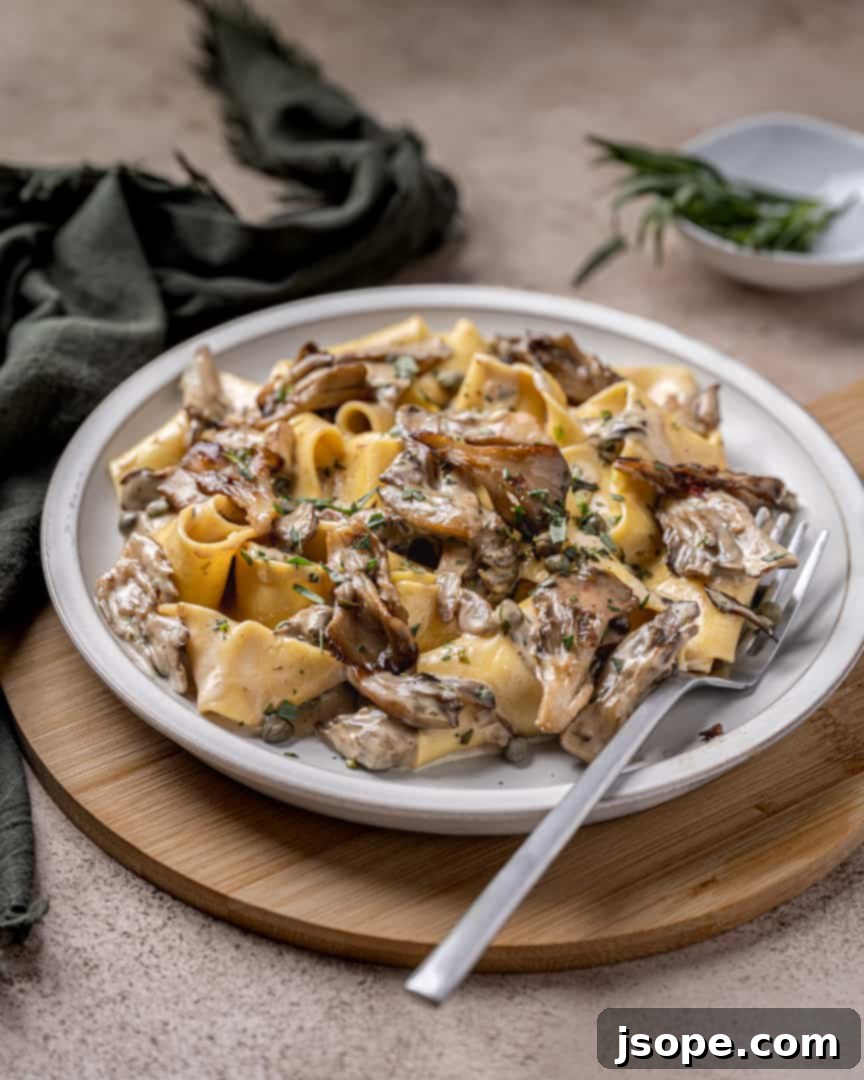
Looking for more delicious pasta recipes to explore? Check these out:
- Marsala Mushroom Casarecce Pasta
- Fettuccine with Winter Spiced Cream Sauce and Rosemary Sage Meatballs
- Baked Rigatoni with Tomato Herb Meat Sauce
📖 The Complete Recipe: Hen of the Woods Pasta with Creamy Tarragon Sauce
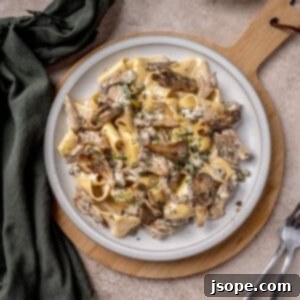
Hen of the Woods Pasta with Creamy Tarragon Sauce
A delicious and rich pappardelle pasta recipe featuring Hen of the Woods mushrooms (maitake mushrooms) in a luscious tarragon cream sauce! This recipe has been rated 5 out of 5 stars by 1 voter.
Equipment
- 1 Large frying pan
- 1 Large pot
- 1 colander
Ingredients
- 8 ounces pappardelle pasta (or 1 recipe Homemade Pasta, cut into pappardelle)
- 1 tablespoon unsalted butter
- 1 tablespoon extra virgin olive oil
- 1 small shallot (finely chopped)
- 2 garlic cloves (minced)
- 8 -10 ounces hen of the woods mushrooms (bite-sized pieces)
- 1 teaspoon kosher salt
- Pinch black pepper
- 3 ounces dry white wine
- 2 cups heavy cream
- A few drops of good balsamic vinegar (⅛ teaspoon or less)
- 1 tablespoon capers (rinsed and dried)
- 1 tablespoon fresh tarragon (finely chopped)
Instructions
- Start by heating a large pot of water over high heat for the pasta. While it comes to a boil, begin preparing the sauce.
- For the sauce, heat a large frying pan over medium heat. Add the unsalted butter and allow it to melt completely. Next, add the finely chopped shallot and cook until it begins to brown lightly, usually for 2-3 minutes. Then, add the olive oil and minced garlic, stirring constantly for about 15 seconds until fragrant, being careful not to burn the garlic.
- Next, add the bite-sized Hen of the Woods mushrooms, kosher salt, and black pepper to the pan. Cook the mushrooms, stirring occasionally. They will initially soak up the liquid and start to brown. Continue cooking until they release their moisture and become golden brown and tender. If the pan seems too dry at any point, you can add a small teaspoon of olive oil.
- Once the mushrooms are beautifully browned, pour in the dry white wine. Cook, stirring, until the wine has almost completely evaporated and reduced, deglazing the pan and picking up all the flavorful bits. Then, add the heavy cream and stir well to combine. Allow the sauce to simmer gently, stirring periodically, until it thickens to a rich, silky consistency that coats the back of a spoon. This reduction process will take approximately 15 minutes, but timing can vary based on your pan size and heat level.
- Once the sauce has reached the desired thickness, stir in the balsamic vinegar (just a few drops for balance), rinsed and dried capers, and finely chopped fresh tarragon. Taste the sauce for seasoning and add a little more kosher salt or pepper if desired. Keep the sauce on very low heat, stirring occasionally, while you prepare your pasta.
- Prepare to cook your pasta by adding a generous spoonful of kosher salt to the vigorously boiling water. When the sauce is complete and the water is boiling, drop the fresh pappardelle pasta into the pot and cook until al dente. For homemade fresh pasta, this typically takes about 2-3 minutes. (If using store-bought pasta, refer to package instructions for cooking time.) Before draining, reserve about ½ cup of pasta water. Drain the cooked pappardelle and immediately transfer it into the pan with the creamy tarragon sauce. If your sauce appears too thick, add a bit of the reserved pasta water, one tablespoon at a time, stirring until you achieve your preferred consistency. Gently toss the pasta in the sauce to combine thoroughly and serve immediately. Enjoy!
Notes
If you are using store-bought pasta, ensure you follow the package instructions precisely to cook it to an al dente finish. Depending on the specific cooking time for your pasta, you may choose to start cooking it while the sauce is reducing. However, the sauce will hold perfectly well on low heat while your pasta cooks, ensuring that the last thing you have is overcooked pasta!
Nutrition
Calories: 732kcal
Carbohydrates: 51g
Protein: 14g
Fat: 52g
Saturated Fat: 30g
Polyunsaturated Fat: 3g
Monounsaturated Fat: 15g
Trans Fat: 0.2g
Cholesterol: 190mg
Sodium: 697mg
Potassium: 646mg
Fiber: 4g
Sugar: 6g
Vitamin A: 1983IU
Vitamin C: 3mg
Calcium: 129mg
Iron: 3mg
Tried this recipe?Let us know how it was!
